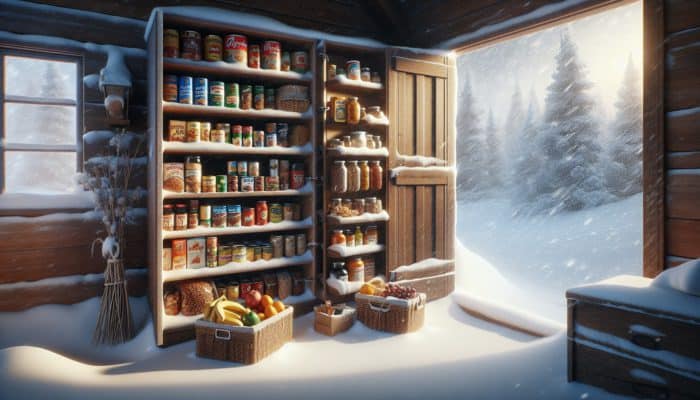Prepare for Blizzard Conditions: A Detailed Action Plan for Food Storage
Effective Strategies for Stockpiling Essential Non-Perishable Foods

As you prepare for an impending blizzard, it is crucial to prioritise the stockpiling of non-perishable foods to ensure you have enough sustenance throughout the storm. These food items are not just convenient but also possess an extended shelf life, making them ideal for emergency situations. They are rich in nutritional values and easy to prepare, providing the necessary energy to help you endure the storm. Consider adding the following vital items to your food storage:
- Canned vegetables and fruits
- Pasta and rice
- Dried beans and lentils
- Canned meats, such as tuna or chicken
- Peanut butter or alternative nut butters
- Granola bars and protein bars
- Powdered milk or shelf-stable dairy alternatives
- Dried fruits and nuts
These selections not only provide substantial nutrition but also require minimal preparation, which is particularly beneficial when the weather is severe and cooking may be impractical. Having these essential staples readily available can greatly enhance your health and energy levels during challenging times, ensuring you are nourished and capable of effectively managing the situation at hand.
Understanding the Viability of Food Supplies During Severe Blizzard Conditions
The length of time your food remains viable during a blizzard can be influenced by several factors, including temperature, packaging, and the type of food itself. Properly stored food can last for several days, but it is essential to understand these variables to optimise your supplies. For instance, food kept in a cool, dry environment typically has a longer shelf life than items subjected to fluctuating temperatures. Grasping how to manage these aspects can greatly assist in effectively planning and maximising your food storage strategies for the storm.
Systematic Organisation of Your Food Supply for Effortless Access
An efficiently organised food supply is essential during blizzard conditions to guarantee quick access and effective inventory rotation. By systematically arranging your food storage, you can swiftly locate the items you need as the storm approaches. Organise your supplies by expiration date and food type. This method not only enhances visibility but also promotes stock rotation, ensuring that older items are consumed first. Maintaining a well-structured storage area can alleviate stress during emergencies, providing peace of mind, knowing that everything is in its designated place.
Expert Recommendations for Efficient Blizzard Food Storage Techniques

Selecting Reliable Containers for Food Storage During Blizzard Conditions
Choosing the right containers for food storage is crucial for maintaining quality and safety amid blizzard conditions. Durable containers that provide insulation and are properly sized for your food items can significantly enhance their longevity. Select airtight containers made from materials such as glass or heavy-duty plastic, as these prevent moisture and pests from compromising your food supply. Furthermore, labelling containers with dates can aid in organisation and ensure that you consume your items within their optimal timeframe, further enhancing your food management strategy.
Real-World Success Stories of Effective Food Storage During Blizzards
Many communities around the globe have encountered blizzards and developed effective strategies for food storage. For example, families in the Midwest of the United States often prepare in advance by stockpiling canned goods and freezing items like meats and vegetables. Certain regions have even created local food banks to guarantee that everyone has access to crucial supplies before a storm hits. These successful strategies highlight the significance of preparedness and community engagement in blizzard food storage, demonstrating the collective strength during challenging times.
Ensuring Food Safety in Cold Weather Conditions

Maintaining food safety during cold weather is of utmost importance. Key considerations include monitoring temperature, employing appropriate storage methods, and preventing contamination. Use a thermometer to ensure your food remains at safe temperatures, especially if storing perishables outdoors. Additionally, keeping food covered and sealing containers can reduce the risk of contamination from external elements, thereby protecting your provisions. Implementing these measures can help ensure that your food remains safe and consumable throughout the storm, safeguarding your health and wellbeing.
Key Considerations for Choosing the Right Food Storage Location During a Blizzard
When selecting an optimal location for food storage during a blizzard, it is essential to consider factors such as accessibility and protection from the elements. An ideal spot would be a cool, dry space that is also easily reachable during a storm. Ensure that the location is secure, enabling you to quickly retrieve essential supplies without needing to brave hazardous weather conditions. By thoughtfully choosing your food storage site, you can significantly enhance your preparedness and response capabilities in the event of a blizzard.
Effective Steps to Prepare Your Food Supplies Before a Blizzard Hits
Preparing your food supplies ahead of a blizzard involves several crucial steps: stockpiling non-perishable foods, organising your storage, and planning meals. It is vital to ensure you have enough supplies to last several days, taking into account potential power outages and limited access to stores. Draft a detailed meal plan that utilises your stored items, ensuring a diverse range of options are available throughout the storm. Being proactive in your preparations can significantly enhance your resilience and self-sufficiency during severe weather events.
Essential Food Items for Complete Blizzard Preparedness
Prioritising Foods for Survival During Blizzard Conditions
When preparing for a blizzard, it is crucial to focus on foods that provide essential nutrients and energy. In addition to the non-perishable items previously mentioned, prioritise energy-dense foods such as canned goods, dried fruits, and nuts. These items deliver quick energy and are lightweight and easy to store, making them ideal for emergency situations. Ensuring your food supply is rich in these nutritional options can help maintain your health and vitality during adverse weather conditions, allowing you to navigate the storm effectively.
Storing Water for Emergency Situations During Blizzard Conditions
Water is an essential component of your emergency supplies, as it is vital for both drinking and cooking. Ensure that you have an adequate supply of water stored in clean, sealed containers. A good guideline is to stock at least one gallon of water per person per day for a minimum of three days. Regularly rotate your water supply to guarantee its freshness, replacing older bottles with new ones to maintain quality. This practice is critical for ensuring you remain hydrated and prepared during a blizzard, which is essential for your overall wellbeing.
Addressing Special Dietary Requirements in Your Blizzard Preparations
Considering special dietary needs is essential during a blizzard. Take into account any allergies or dietary restrictions when stocking your food supplies. Including alternatives such as gluten-free grains, plant-based proteins, and low-sodium options ensures that everyone in your household can maintain their health and wellbeing, even amidst challenging conditions. By planning ahead, you can ensure that all dietary requirements are met, making your food storage strategy inclusive and effective for all family members.
Research-Backed Benefits of Effective Blizzard Food Storage Practices
Create a Comprehensive Food Storage Plan with Practical Steps
Developing a robust food storage plan requires careful planning and organisation. Start by creating an inventory of your current supplies and compiling a list of additional items you need. Establish a timeline for purchasing these items, ideally well before the onset of blizzard season. A useful checklist might include tasks such as organising your pantry, labelling containers, and planning meals that utilise your stored items. Following these actionable steps can significantly enhance your preparedness for extreme weather events, ensuring you are always ready.
Impact of Proper Food Storage on Health During Emergencies
Proper food storage plays a vital role in maintaining health during emergencies. A well-stocked food supply guarantees access to nutritious options, thereby preventing spoilage and waste. By prioritising nutrient-dense foods and storing them correctly, you can ensure your family receives essential vitamins and minerals, even in adverse conditions. This focus on health is crucial for sustaining energy and wellbeing during challenging times, underscoring the significance of effective food storage practices to support your family’s health.
Understanding the Psychological Benefits of Being Prepared for Severe Weather
Having a well-thought-out food storage plan in place can significantly reduce stress and anxiety during blizzard conditions. The knowledge that you are prepared provides a sense of security and calm amidst uncertainty. Experts indicate that preparedness fosters resilience, empowering individuals and families to face challenges confidently while alleviating feelings of helplessness. This psychological aspect of readiness greatly enhances your overall experience during extreme weather events, making it a critical consideration in your preparation strategies.
Evaluating the Cost-Effectiveness of Blizzard Food Storage Solutions
The financial advantages of implementing a food storage system for blizzards can be significant. While there may be initial setup costs, maintaining a well-stocked supply can lead to substantial savings during emergencies, as prices frequently surge when demand increases. Additionally, purchasing in bulk can yield savings, and avoiding last-minute grocery runs during storms can prevent unnecessary overspending. By assessing the cost-effectiveness of your food storage strategy, you can make informed decisions that benefit both your finances and your preparedness efforts.
Best Practices for Rotating and Maintaining Your Food Stock
Efficient Methods for Rotating Your Food Supplies
Adopting a first-in, first-out (FIFO) system represents the most effective strategy for rotating your food stocks. This approach ensures that older items are consumed first, maintaining freshness and minimising waste. To facilitate this process, label items with purchase or expiration dates and arrange your storage so that the oldest items are at the front. Implementing FIFO not only helps preserve the quality of your food supplies but also serves as a straightforward yet effective strategy for ensuring your provisions are consumed before their expiry dates.
Inspecting for Spoilage and Contamination in Your Food Stock
Regularly inspecting your food stock is essential to ensure safety and quality. Checking for signs of spoilage or contamination involves observing changes in colour, smell, or texture. Properly stored food should remain intact; if anything appears questionable, it is advisable to err on the side of caution and discard it. This vigilance not only protects your health but also ensures that your food supply remains dependable and safe during emergencies, enabling you to rely on your provisions when they are needed most.
Restocking Your Supplies After a Blizzard Event
Once the blizzard has passed, it is imperative to evaluate your food supply and replenish what was consumed. Take stock of your inventory, identify which items are low, and restock according to your current needs and the likelihood of future storms. Keeping your supplies fresh and current ensures you are always prepared for the next weather event. This proactive approach can significantly enhance your resilience and readiness for future challenges, ensuring you are never caught off guard again.
Optimising Your Food Storage Space for Maximum Efficiency
An organised food storage area can significantly impact your preparedness during emergencies. Arrange your storage space to improve accessibility and visibility. Group similar items together and place frequently used products at the front. This organisation not only simplifies finding what you need during a storm but also supports an efficient stock rotation system. By maintaining order, you can reduce stress and ensure your preparations are both effective and practical.
Proven Strategies for Effective Blizzard Food Storage
Fundamental Principles for Efficient Food Storage
To maintain an effective food storage system during blizzard conditions, adhere to fundamental principles such as ensuring a cool, dry environment, using airtight containers, and organising items by expiration date. These practices help preserve your food’s freshness, reduce spoilage, and ensure easy access during emergency situations. By following these principles, you can optimise your food storage strategy and significantly enhance your preparedness for severe weather events, ensuring your supplies remain reliable and safe.
Significant Benefits of Effective Food Storage During Blizzards
A well-prepared food storage system offers numerous benefits essential for enduring a blizzard, including:
- Peace of mind during emergencies
- Nutritional security for your family
- Reduced stress and anxiety levels
- Financial savings by avoiding last-minute purchases
- Greater independence and self-sufficiency
- Minimised food waste through effective rotation
- Ability to respond promptly to changing conditions
- Enhanced community resilience through shared resources
These benefits highlight the importance of being proactive in your food storage planning, ensuring that you are well-prepared for any blizzard, thereby safeguarding your health and wellbeing during the storm.
Collaborative Community Approaches to Effective Food Storage Practices
Communities can significantly strengthen their overall readiness for blizzards through collaborative food storage planning. By sharing resources, knowledge, and support, neighbourhoods can establish collective food storage initiatives. Organising community food banks or resource-sharing programmes ensures that everyone has access to essential supplies, cultivating a sense of solidarity and preparedness. This collaborative approach not only fortifies community bonds but also enhances resilience against severe weather events, ultimately benefiting all members of the community.
Best Practices for Rotating Your Blizzard Food Supplies
To effectively rotate your blizzard food supplies, implement a rotation system whereby older items are used first, ensuring freshness and minimising waste. Regularly check and update your inventory, labelling items with dates to track their shelf life. This practice not only keeps your food secure but also promotes responsible consumption, particularly during challenging weather conditions. By being diligent about rotation, you can maximise the utility of your food supply, ensuring you always have fresh options available.
Frequently Asked Questions About Blizzard Food Storage
What types of non-perishable foods should I stock for a blizzard?
Focus on canned goods, dried fruits, nuts, pasta, rice, and shelf-stable dairy alternatives. These foods provide essential nutrients and energy while boasting long shelf lives, making them ideal for emergencies.
How much water should I store for emergencies?
A good guideline is to store at least one gallon of water per person per day, sufficient for drinking and cooking, for a minimum of three days.
How can I ensure my food remains safe in freezing temperatures?
Regularly monitor temperatures and utilise airtight containers. Ensure food is covered and stored properly to prevent contamination from external elements, thus keeping your supplies secure and safe.
How often should I inspect my food stock?
Inspect your food stock at least once a month, checking for spoilage and ensuring items are within their expiration dates to maintain quality and safety.
What is the best way to organise my food storage space?
Group similar items together, label containers with dates, and place frequently used items at the front for easy access. This organised approach enhances efficiency during emergencies, ensuring you can find what you need when it matters most.
Can I use regular plastic containers for food storage?
While some plastic containers are acceptable, opt for heavy-duty, airtight options to ensure food quality and safety, particularly during extended storage periods for perishable items.
What should I do with expired food after a blizzard?
Discard any expired items and always err on the side of caution if food appears suspicious in terms of look or smell, prioritising safety above all else.
How can I prepare meals with stored foods during a blizzard?
Plan meals in advance using your stored items, focusing on quick and easy recipes that require minimal cooking. This preparation ensures you can efficiently utilise your supplies during the storm, making mealtimes manageable and satisfying.
Is it cost-effective to invest in food storage for emergencies?
Yes, while there may be initial investment costs, a well-planned food storage system can save money by preventing last-minute purchases during emergencies when prices may surge due to high demand.
How can communities improve their food storage readiness for blizzards?
Communities can collaborate by sharing resources, establishing food banks, and providing workshops on effective food storage practices, thereby enhancing overall preparedness for severe weather events and ensuring everyone has access to necessary supplies.
Explore our world on X!
The post Blizzard Food Storage: Essential Tips and Techniques appeared first on Survival Bite.
The Article Blizzard Food Storage Tips and Techniques You Need to Know Was Found On https://limitsofstrategy.com
The Article Blizzard Food Storage Techniques You Must Know First Appeared ON
: https://ad4sc.com
Comments are closed